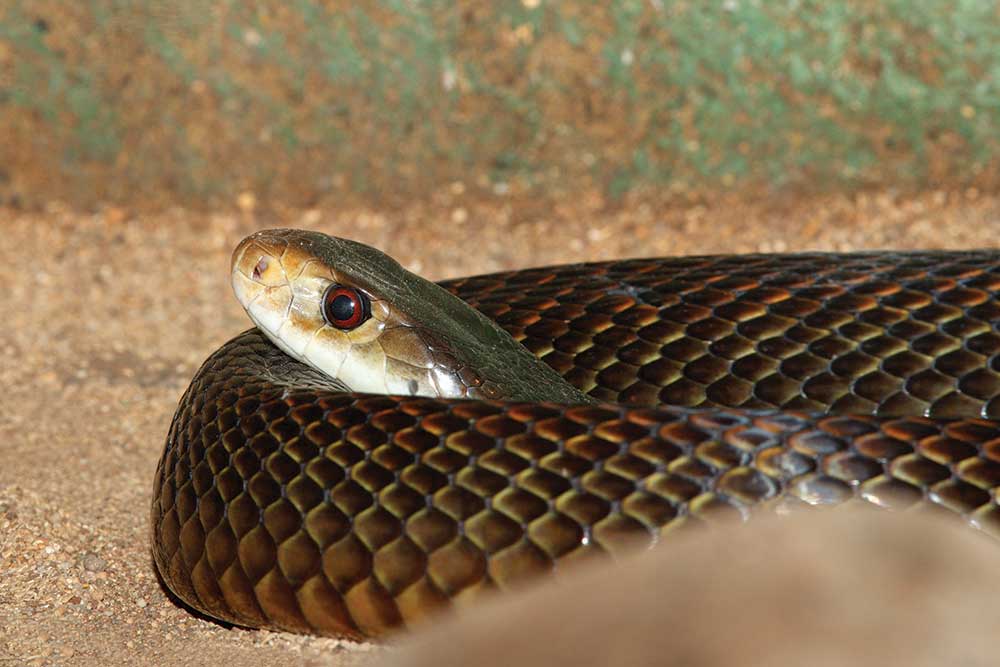If you’re visiting Australia, be careful of cattle, horses, crocodiles, and kangaroos—they, like most everything in the Land Down Under can kill you! The snakes can be pretty deadly too if you don’t get treatment.
Australia doesn’t lack for venomous snakes. There are 66 recognized species of venomous snakes on the continent. More impressive
(or fear-inducing) is the insane toxicity of some of Australia’s snakes. In some rankings, Australia is home to each of
the top 11 most venomous snakes in the world.
Of course, venomous isn’t directly equal to toxicity or danger. A massive amount of relatively mild venom may be less concerning than a much lower dose of a stronger venom. Even more important to us humans is the behavior and habitat of the snake species. If people rarely see a timid snake that only lives in unsettled areas, is it more dangerous than an aggressive snake in the suburbs? Perhaps because they have such powerful venom, Australia’s snakes are not generally aggressive toward non-prey (us!) Venom is primarily intended for hunting, with defense usually a last resort.
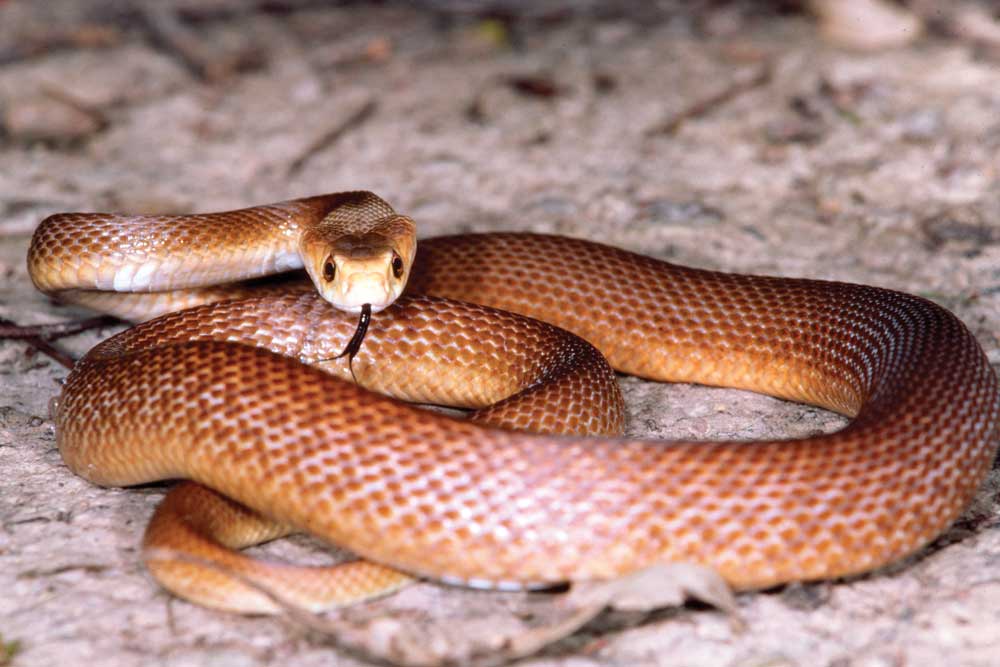
The coastal taipan is the second longest venomous snake in Australia. Photos by Ken Griffiths/Shutterstock
The good news for Australians and visitors alike is that venomous snake bites are rare and only a handful of deaths are recorded each year on the continent. In fact, deaths from horses, cattle, and kangaroos each average about six times more deaths a year than reptiles, according to some statistics. Effective antivenins exist for the deadliest snakes, resulting in potentially long and painful hospital visits, but fatalities are exceedingly rare with prompt treatment.
As you should any time you are bitten, get as good a description of the snake as possible, but do not attempt to collect the snake. The hospital/doctor does NOT need or want the snake and you risk additional injury and are wasting valuable time. All of Australia’s venomous snakes are protected by law, so killing the one that bit you isn’t just pointless, it is illegal.
Two Venomous Australian Snakes Came By Sea, Not Land
Top 10 Venomous North American Snakes
Stormtrooper Armor Saves Australian Man From Venomous Snake Bite
Also, don’t take inspiration from popular culture—whisky isn’t a cure and even mild intoxication can interfere with your treatment. Never attempt to suck the venom from the wound or allow anyone else to try it—it simply doesn’t help and is dangerous to you both. Loud swearing might be appropriate, but you still want to put a compress over the wound and get to a doctor.
You don’t want to be bitten by any of these snakes. All of them can kill and have at least one documented fatality. At the least they can seriously mess you up if you don’t get treatment. Here are 10 of the most dangerous Australian snakes. They really aren’t ranked by danger, because the most dangerous is of course the one ready to strike you.
Coastal Taipan (Oxyuranus scutellatus)
Despite our refusal to rank these venomous snakes, the coastal taipan certainly makes a case for itself as nightmare fodder. Common along the eastern coast, the coastal taipan tends to prefer sugar cane fields and other agricultural settings. Although not aggressively seeking confrontation, when surprised, the snake is known to literally launch itself at its target and deliver multiple quick bites. With a neurotoxic venom that is the third most powerful of any land snake, getting help quickly is essential. Prior to the late 1950s when an effective antivenin became available, nearly all bites were fatal and could occur in as little as 60 minutes. The fangs of the coastal taipan are among the longest (13 mm) of any Australian snake and there are documented cases of a bite through a victim’s boots and thick socks requiring hospitalization.
The second longest venomous snake in Australia, they commonly grow to more than 6.5 feet (1.9 meters), with a recorded maximum length of 9.5 feet (2.8 meters) and about 14 pounds (6.3 kilograms) though experts expect some may reach lengths exceeding 11 feet (3.3 meters). Although not related, the coastal taipan is closely aligned with Africa’s black mamba in toxin power, hunting behavior, size, and shape. Mice, rats, and other smaller mammals, as well as birds are preferred prey. One dead specimen (road kill) was found to have ingested a cane toad. It isn’t known if this is a common prey or if the snake is resistant to the toad’s poison. It is believed the coastal taipan population has grown significantly since the introduction of the cane toad as many other venomous snake populations have declined somewhat. It hasn’t been determined yet whether the increase is due to lessened competition for prey or another factor, perhaps including the addition of the toad as viable prey.
In addition to a large range along the eastern portion of Australia, a subspecies is found in New Guinea. Active yearlong, the coastal taipan are not found in areas where winter temperatures drop below the mid 60s Fahrenheit (17.2 to 18.3 degrees Celsius). They are primarily sight hunters that appear to be most active during mornings, but have been observed hunting nocturnally during hot and dry weather.
Common Death Adder (Acanthophis antarcticus)
The venom of the common death adder isn’t among the most potent in Australia (but would rank very high anywhere else). Prior to development of an antivenin, “only” about half the people bit would be expected to die, often from paralysis and respiratory failure within two hours of being bitten. What makes the death adder so dangerous is its hunting style. It is a classic ambush hunter that hides in leaf litter and other cover. It doesn’t flee when it senses approaching footsteps. Fortunately, it isn’t overly aggressive unless touched. Unfortunately, because it is very good at hiding, it is easy enough to step on, or kick the snake.
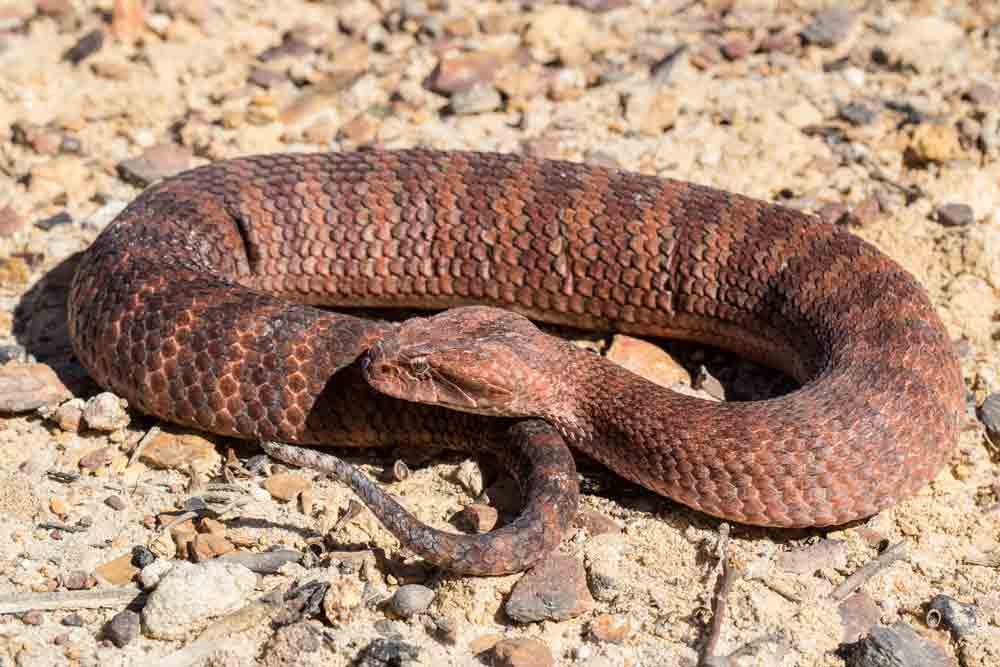
The common death adder is in decline due in part to the invasive cane toad. Photo by Shutterstock
The stout, but relatively short (typically 2-3 feet or .60 to .90 meters), ambush hunter features long fangs rivaling the coastal taipan as has the fastest strike in Australia. Although still living up to the common portion of its name, the death adder population is currently in decline. The cane toad preys on juvenile death adders and adult Adders that return the favor succumb to the toxins in the toad’s skin. Unlike other Australian snakes, the death adder gives live birth with an average of 10 to 20 offspring.
Eastern Brown Snake (Pseudonaja textilis)
The Eastern brown snake packs the second most powerful venom in the world based on median lethal dose (LD50) values. With a ridiculously toxic bite, it takes little venom to cause headaches within 15 minutes and possible cerebral hemorrhage or heart attack in an hour. It is little consolation that this rodent-hunting snake has the smallest fangs and lowest volume venom of the snakes in this list.
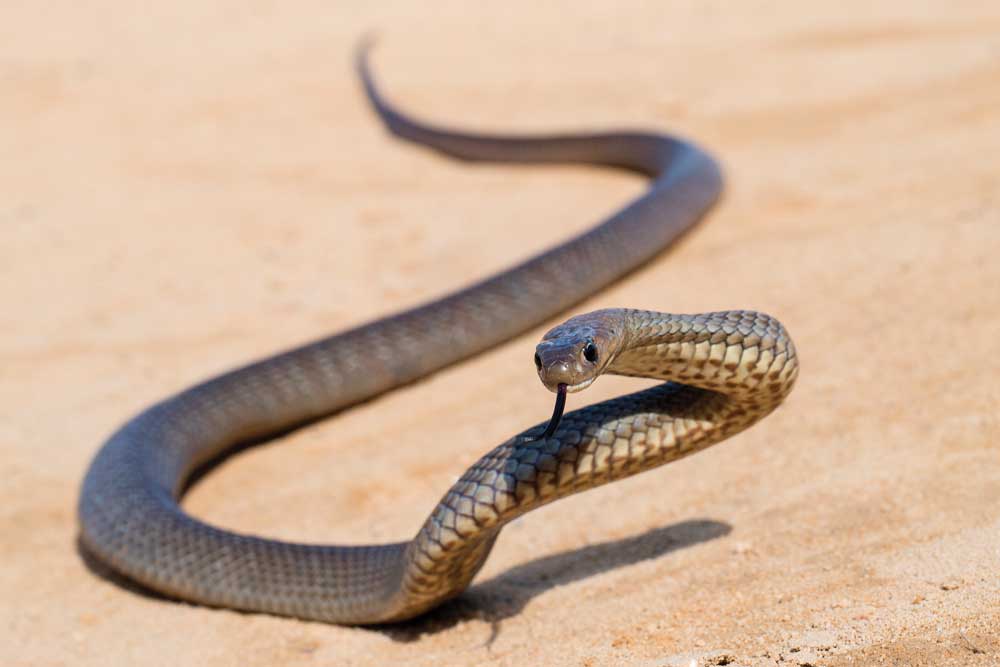
The Eastern brown snake grows to about 6 feet in length, with a few specimens growing even larger. Photo by imagevixen/Shutterstock
When attacking or defending itself, it raises its head, resulting in most human bites occurring on the upper thigh. It sometimes will encircle and constrict prey following a bite, holding it until it expires. It isn’t considered an especially aggressive species. Most adults are in the 6-feet (1.8 meters) range, with some reaching 7.5 feet (2.2 meters), or longer. The Eastern brown snake is quite slender for its length.
Hunting typically involves tracking prey into its warren or other shelter and once it finishes feeding, it is known to inhabit the shelter until it returns to the hunt. It is a day hunter, although juveniles often hunt at night, especially during the warm seasons. It becomes inactive and brumates through the winter, nearly half of the year.
By far the most common cause of snake bite deaths in Australia, the Eastern brown snake tends to live in suburbs and farmlands where its favorite prey, the introduced house mouse is common. Because it tends to favor warmer, drier areas, its range doesn’t bring it into heavy contact with the cane toad and therefore its population is relatively stable.
Inland Taipan (Oxyuranus microlepidotus)
The inland taipan is also known as the fierce snake not for its demeanor, but for its deadly bite. Even for Australia, its venom is over the top. Easily the most powerful of any reptile in the world, it is more than twice as deadly to mammals as the next contender, a sea snake and a whopping six times as powerful as the Eastern brown which has the second most vicious venom of any land snake.
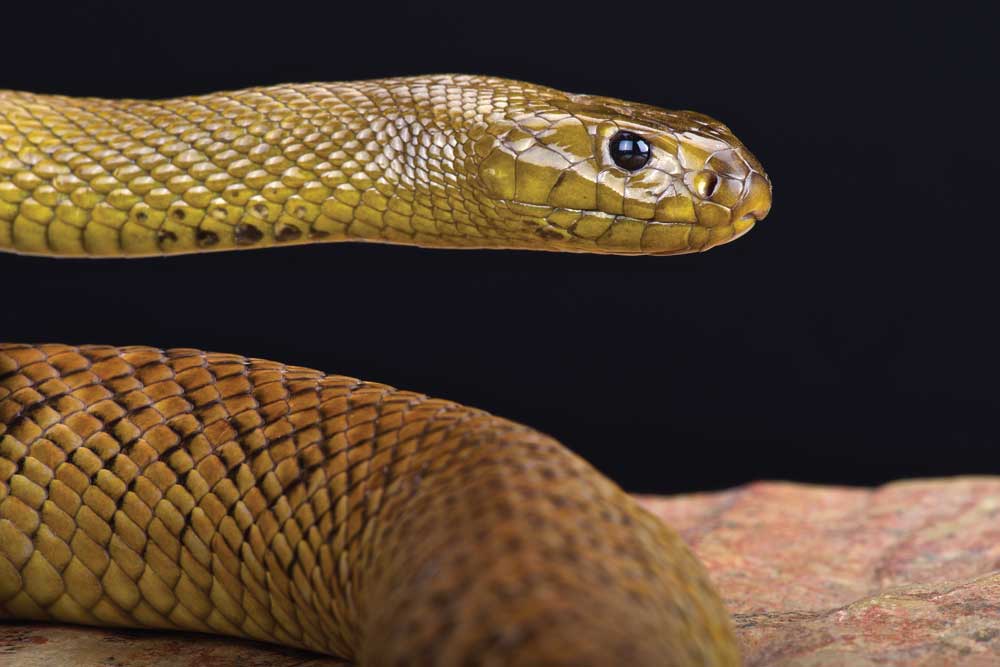
The inland taipan snake is also known as the fierce snake. Photo by reptiles4all/Shutterstock
Well-known to the indigenous people of the continent, early European naturalists encountered and named the snake in the late mid-1800s. When no one captured the reclusive snake for decades, biologists mistakenly decided it was a myth and probably “just” a misidentified coastal taipan or common brown. It wasn’t until the 1970s, nearly a century after it had last been identified, that specimens were once again found.
Exclusively feeding on mammals such as rats and other rodents, the inland taipan nearly always envenomates when it strikes, and unlike most venomous hunters, it doesn’t release its prey in order to avoid a struggle, it simply strikes many times. With each strike delivering more than enough venom to quickly and painfully kill 100 people, a rat or rabbit succumbs pretty quickly.
Without prompt treatment with an antivenin, bites are most likely fatal to even healthy full-grown men. Even with massive amounts of antivenin, many bite victims can expect months of hospitalization and potentially permanent kidney, heart and brain damage.
Despite its fierce bite, the snake is considered relatively docile, which combined with its remote habitat in the arid areas of inland Eastern central Australia, means human bites are extremely rare. Almost all known inland taipan bites in the last 40 years have been to professional snake handlers.
Average length of adults is approximately 6 feet (1.8 meters), but larger specimens can approach 9 feet (2.7 meters). They lay between 12 to 24 eggs, typically in burrows. Even freshly hatched juveniles have fully potent venom. A few other venomous snakes, particularly the Mulga (Pseudechis australis) are immune to the taipan venom and will attack and kill smaller snakes. A large monitor lizard, the Perentie (Varanus giganteus), preys on even full-grown inland taipans.
King Brown Snake (Pseudechis australis)
As the name implies, the king brown snake is large, the largest of Australia’s venomous snakes. Ironically, it isn’t always brown and its potent venom is best countered with black snake antivenins. A highly variable species also known as the mulga snake, it can grow to more than 11 feet (3.3 meters), primarily in the more northern areas of its reach. Again, it can vary from a somewhat slender to more typical stocky build with larger specimens approaching 15 pounds (6.8 kilograms). Colorization can vary from very dark, nearly black to light tan that highlights a reticulated pattern with a belly that varies from bright orange to a light tan.
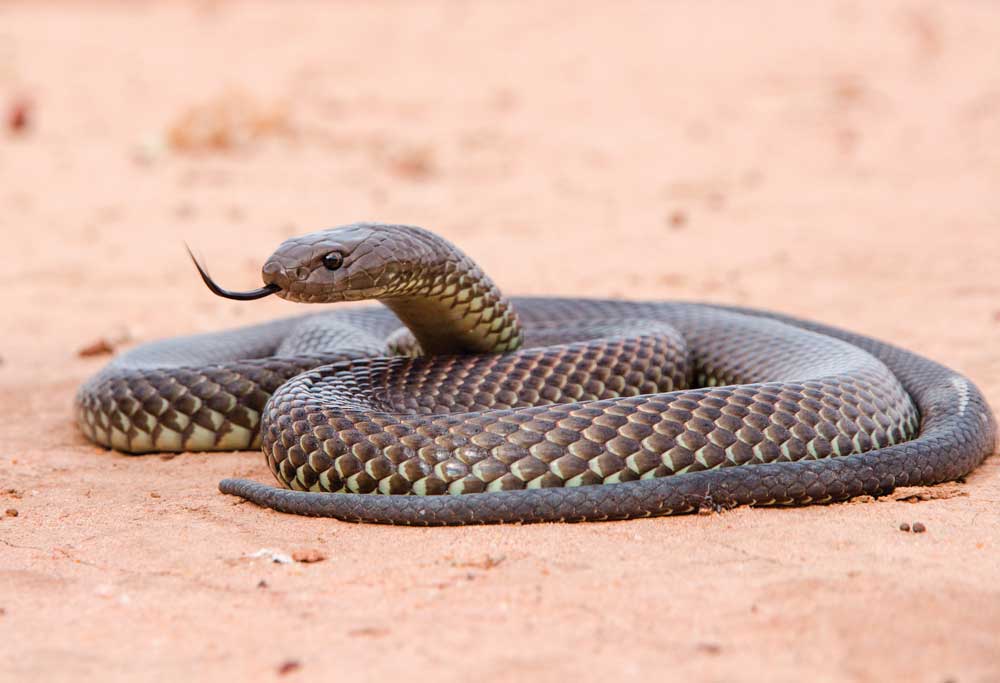
The high visual variation within the species, combined with its large range, means that the king brown is often misidentified in the field. Photo by Ken Griffiths/Shutterstock
The high visual variation within the species, combined with its large range, means that it is often misidentified in the field. The snakes are found in nearly every Australian state. With such a large and varied range, the king brown is both a habitat and food source generalist. It is found in dry arid areas, but relatively close to water sources, to fields and wooded areas. It preys on other snakes, lizards, frogs, small mammals, and even the cane toad, although observational evidence shows that the snake will avoid the toad and its poison secretions.
The good news for bite victims is that the king brown’s venom is relatively mild (in Australian terms) and quite survivable when black snake antivenin is introduced within a few hours. Even without prompt treatment, it isn’t likely fatal, but serious muscle and kidney damage is likely. The bad news is that the king brown typically strikes repeatedly and frequently “chews” to deeply envenomate targets. It also has a massive amount of venom, by some measures the largest payload of any venomous snake in the world. One large captive has produced a whopping 1.5mg of venom in a single milking session—additionally, the primarily myotoxic venom is almost entirely injected into the victim with almost none left on the skin.
Primarily an afternoon and evening hunter, king brown’s are not a particularly aggressive snake and are commonly kept by licensed handlers and wildlife facilities. Although interaction with humans are rare, there are verified instances of the snake biting sleeping subjects.
Red-bellied Black Snake (Pseudechis porphyricus)
Not quite the nightmare-inducing serpent of its Australian counterparts, it’s perhaps to be expected that the red-bellied black snake is popular with Aussie reptile keepers. Of course, anywhere else in the world it would be rightly feared for its ability to cause considerable damage.

The red-bellied black snake lives on the Eastern coast of Australia. Photo by Martin Pelanek1/Shutterstock
A moderately-sized snake, typically about 4 feet (1.2 meters) in length with rare instances exceeding 8 feet (2.4 meters), a large specimen can weigh more than 22 pounds (9.9 kilograms). It is commonly encountered by people, even in urban settings and is the primary source of snakebites among dogs in Australia.
Although there are no human deaths attributed to the snake, serious bites have required more than a week of recovery even with antivenin and have resulted in amputations. Red-bellied black snakes live along the Eastern coast of Australia and prefer wet, marshy areas or ponds as they prey primarily on frogs, fish, other snakes, and sometimes small rodents. They produce live births, typically less than 30 at a time.
The shiny black snake will attempt to avoid confrontation and generally only attacks when seriously provoked. Although cohabitating with the cane toad, already some studies suggest it has become slightly tolerant of the amphibian’s secretions and tends to avoid it as prey. Despite this adaptation, their numbers are in decline due to habitat fragmentation and predation from feral cats which are resistant to its venom.
Mainland Tiger Snake (Notechis scutatus)
The tiger snake is another highly variant species of venomous serpent. There is disagreement over whether it contains subspecies (primarily variants found on islands, including Tasmania) or is a single classification. Either way, it accounts for a significant percent of reported snake bites (about 17 percent) with untreated fatality estimate at about 50 percent.
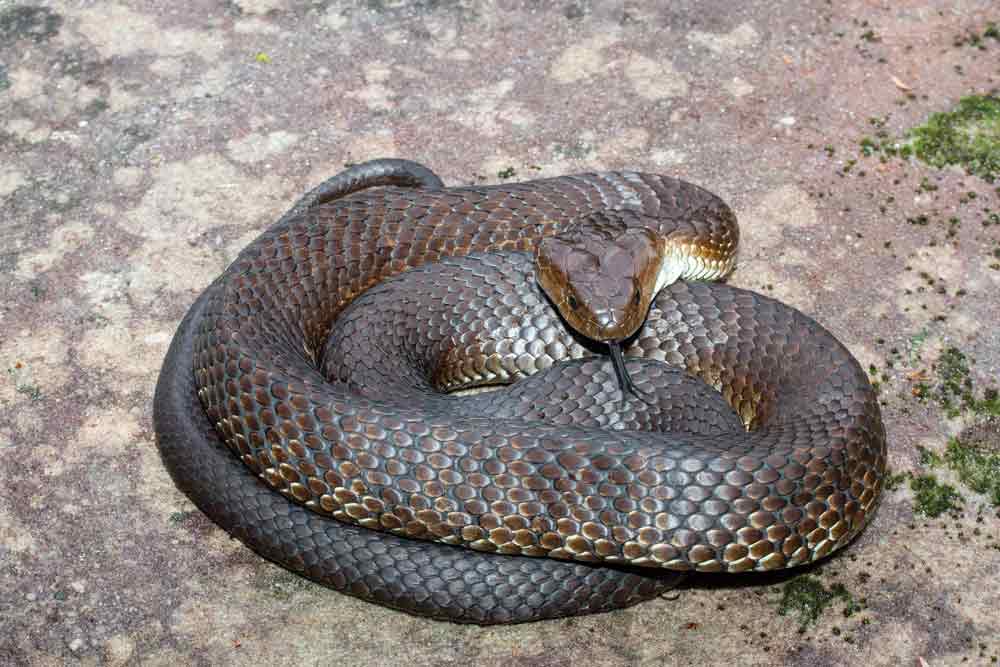
A mainland tiger snake with barely visible banding. Photo by Ken Griffiths/Shutterstock
A stout species, typical length is about 4 feet (1.2 meters), with a record exceeding 6 feet (1.8 meters). Tiger snakes are found all around the coastline of Australia and prefer extremely wet habitats and are strong swimmers. They have also been observed climbing trees. They are relatively cold tolerant and can hunt into the early evening. They are a live bearing species.
Because their colorization can be so variable (including the absence of the tiger-like striping), identification to determine which antivenin is appropriate is done by analyzing the bite area.
Western Brown Snake (Pseudonaja mengdeni)
There has been plenty of confusion regarding the Western brown snake. Because there are many varieties of brown snakes in Australia and the Western is quite variable in color occurring in near black to light tan, it is often misidentified with its Eastern counterpart.
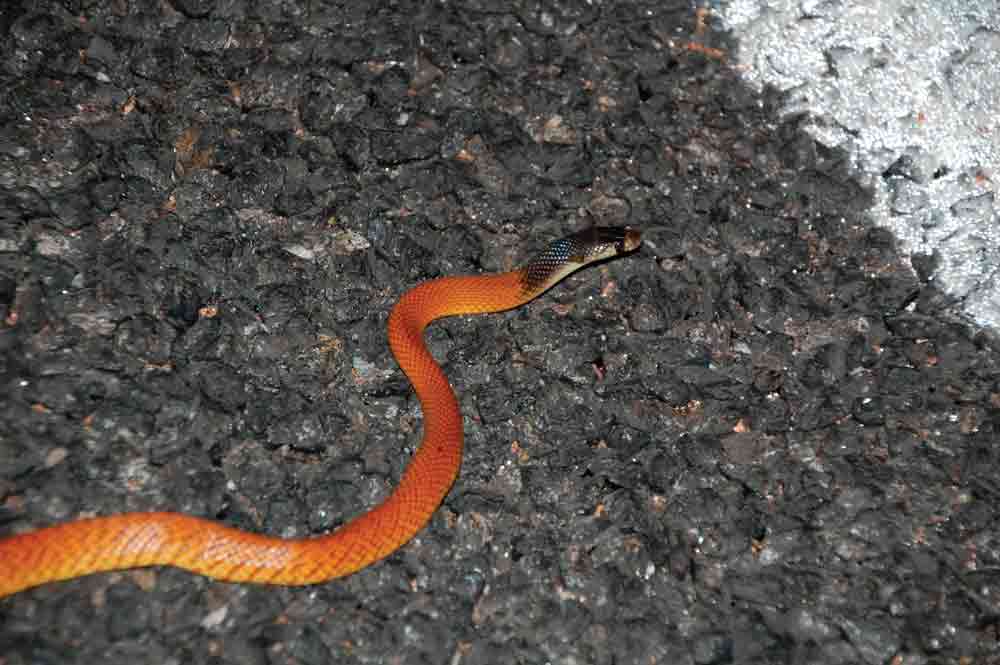
Western brown snakes can be found in Western and Central Australia. Photo by Owen65/Shutterstock
The long (up to about 7 feet or 2.1 meters, but typically about 5 feet or 1.5 meters) and thin snake is very fast. Mostly active during the day, in warmer temperatures it will hunt into the night. It is an egg layer with clutch sizes from 12 to sometimes 36 eggs. Males will fight and bite other males (they are immune to their own venom) during mating season to gain access to the female. Although primarily a ground hunter, Western browns can and will climb trees.
The Western brown snake has an extremely wide and varied range. It can be found in almost every habitat in Western and Central Australia except the wettest areas. It overlaps range with the Eastern brown, adding to misidentification. It is an opportunistic hunter feeding on other snakes, rodents, ground nesting birds, and lizards. Although its venom isn’t as potent as the Eastern brown, it typically produces three times the dose of its still toxic venom. Immediate treatment is required as the venom can be fatal to humans. It will attack humans if provoked, but prefers to avoid contact.
Even though it can be difficult to identify, as with ALL venomous snakes, capturing it after a bite should never be done. Australian hospitals are adept at diagnosing and treating a variety of snake bites.
Eastern Small-eyed Snake (Rhinoplocephalus nigrescens)
A smaller snake, the Eastern small-eyed snake averages less than 2 feet in length (0.60 meters), with larger specimens hitting as much as 4 feet (1.2 meters). It gives live birth to a handful of babies and preys almost exclusively on other reptiles (snakes, including its own species, lizards, skinks, and possibly frogs).
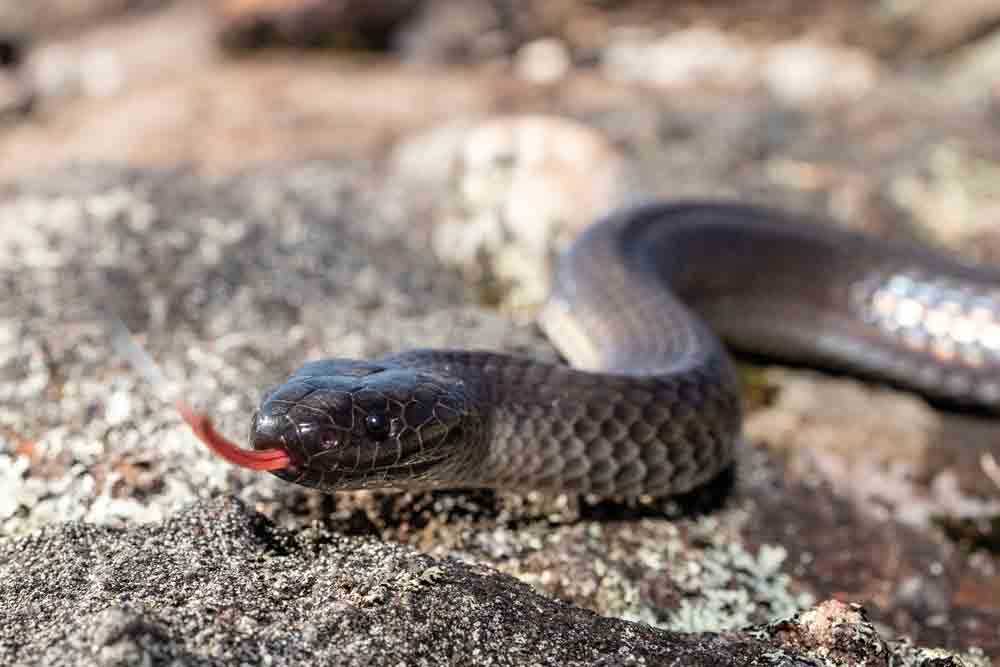
The Eastern small-eyed snake grows to less than 2 feet in length and preys almost exclusively on other reptiles, including its own species. Photo by Ken Griffiths/Shutterstock
It is a nocturnal hunter that employs both active searching for resting diurnal (active in the daytime) prey and ambush hunting. Because it is active at night, it rarely interacts with humans over it large (Eastern coastal range). Additionally reassuring is it reluctance to envenomate. Typically, it will thrash wildly and attempt to retreat rather than bite. Even when it does bite, its venom isn’t among the most deadly and may result in few or even no symptoms. However, the myotoxin venom is very slow acting and has caused death from muscle (primarily heart) damage that can surface as much as a week after the bite. As with any venomous snake bite, seek medical care, even if you feel fine.
Lowland Copperhead (Austrelaps superbus)
Not closely related to the North American copperhead, Australia’s lowland copperhead is responsible for more than a dozen confirmed bites and a fatality in recent years. A moderate-sized elapid with typical lengths of 3 to 4 feet (0.9 to 1.2 meters) and highly variable coloration from a reddish rust to tan, near black, or even yellow (sometimes without the namesake copper head). The snake prefers wetter habitats in the extreme south eastern areas of Australia and nearby southern islands.
Its preferred prey is snakes, frogs, and lizards that it tends to hunt along the edges of waterways. It does prefer low vegetation and will take small rodents when available. The combination of cropped vegetation and house mice common in suburbs has resulted in slightly increased populations.
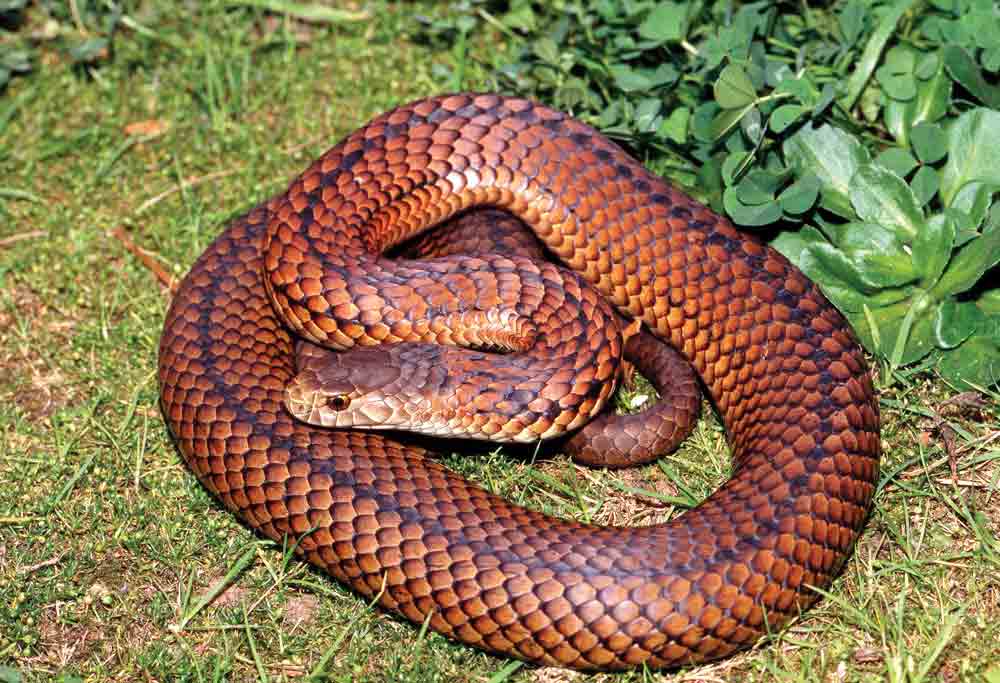
The lowland copperhead feeds on snakes, frogs and lizards. Photo by Ken Griffiths/Shutterstock
It is a daytime hunter. It gives live birth to relatively small numbers (less than a dozen) as often as annually. It is not an aggressive snake and even when disturbed it generally will engage in prolonged warning behavior, including mock strikes, hissing, neck flattening, or thrashing. If you are bit, it does have a powerful neurotoxic venom that can be successfully treated with tiger snake antivenin.
Australian Venomous Snakes
If you’re visiting Australia, be careful of cattle, horses, crocodiles, and kangaroos—they, like most everything in the Land Down Under can kill you! The snakes can be pretty deadly too if you don’t get treatment.
J.V. Bolkan enjoys herping in his native Oregon.

